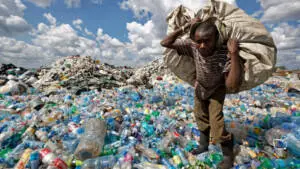Plastic, a versatile material that has become an integral part of our daily lives, has also emerged as a significant environmental concern. In this article, we will explore the various aspects of plastic, its impact on the environment, and what we can do to address the growing problem of plastic pollution.

The Rise of Plastic
Plastic production has skyrocketed in the last century. From everyday items like water bottles and grocery bags to complex electronic devices, plastic is omnipresent. Its popularity stems from its durability, affordability, and versatility. However, this ubiquity comes at a steep environmental cost.
Types of Plastics
1. Single-Use Plastics
Single-use plastics, such as straws, cutlery, and disposable cups, are designed for convenience but often end up as pollution in oceans and landfills.
2. Microplastics
Microplastics are tiny plastic particles that can be found in personal care products and result from the degradation of larger plastic items.
Plastic in Our Oceans
3. Marine Life Impact
The oceans are home to a diverse range of marine life, but plastic pollution threatens their existence. Sea creatures often mistake plastic debris for food, leading to ingestion and harm.
4. Ecosystem Disruption
Plastic pollution disrupts aquatic ecosystems, affecting not only marine life but also the delicate balance of underwater environments.
Environmental Consequences
5. Air Pollution
The production and incineration of plastic contribute to air pollution, releasing harmful chemicals into the atmosphere.
6. Land Pollution
Plastic waste accumulates in landfills, taking centuries to decompose fully and leaching toxic substances into the soil.
Human Health Concerns
7. Toxic Chemicals
Plastics contain various toxic chemicals, such as BPA, that can leach into food and water, potentially causing health problems.
8. Ingestion of Microplastics
Recent studies suggest that humans may unknowingly consume microplastics through food and water, raising concerns about long-term health effects.
Combating Plastic Pollution
9. Reducing Single-Use Plastics
Individuals and businesses can take steps to reduce single-use plastics by opting for reusable alternatives.
10. Recycling and Upcycling
Proper recycling and upcycling of plastic waste can significantly reduce its environmental impact.
11. Supporting Legislation
Advocating for and supporting policies aimed at reducing plastic production and promoting eco-friendly alternatives is crucial.
FAQs
1. What is the most common type of plastic found in the ocean?
The most common plastic found in the ocean is polyethylene, used in items like plastic bags and bottles.
2. How can individuals reduce their plastic footprint?
Individuals can reduce their plastic footprint by using reusable items, recycling, and supporting businesses that prioritize eco-friendly packaging.
3. Are biodegradable plastics a viable solution?
While biodegradable plastics break down faster than traditional plastics, they still require specific conditions to decompose fully and may not be a perfect solution.
4. What are the alternatives to single-use plastics?
Alternatives to single-use plastics include glass, metal, and paper products, as well as reusable containers and bags.
5. How can I get involved in the fight against plastic pollution?
You can get involved by participating in local clean-up efforts, supporting organizations dedicated to plastic reduction, and raising awareness among your community about the importance of reducing plastic waste.
Conclusion
Plastic pollution is a pressing global issue that affects our environment, marine life, and even human health. To mitigate this problem, it is essential that we collectively take action to reduce plastic usage, promote responsible disposal, and support initiatives that seek to find sustainable alternatives to plastic products.
